Wind Farm with Series Arrangement, ANSYS Fluent CFD Simulation Training
$160.00 $80.00 Student Discount
- The problem numerically simulates the Wind Farm with Series Arrangement using ANSYS Fluent software.
- We design the 3-D model by the Design Modeler software.
- We Mesh the model by ANSYS Meshing software, and the element number equals 4154166.
- We use the Frame Motion model to define the rotational movement.
To Order Your Project or benefit from a CFD consultation, contact our experts via email (info@mr-cfd.com), online support tab, or WhatsApp at +44 7443 197273.
There are some Free Products to check our service quality.
If you want the training video in another language instead of English, ask it via info@mr-cfd.com after you buy the product.
Description
Description
The present problem simulates wind turbines with the series arrangement in a wind farm using ANSYS Fluent software. We perform this CFD project and investigate it by CFD analysis.
The wind turbines studied in this project are horizontal axis wind turbines (HAWT), Which means that the ambient wind flow is parallel with the turbine’s axis horizontally.
The present model is designed in three dimensions using Design Modeler software. In this project, a computational domain has been designed for ambient wind flow, with a length of 240 m, a width of 30 m, and a height of 53 m.
Four horizontal-axis wind turbines with three blades are designed within this computational area. These turbines are located consecutively in the same direction and at a distance of 30 m from each other.
A distinct area is designed around these four turbines to apply the frame motion model and define the rotational motion of the turbine, which has a diameter of 18 m and a width of 3.1 m.
We carry out the model’s meshing using ANSYS Meshing software. The element number is 4154166.
Wind Farm Methodology
In this project, four wind turbines are designed in a row in a specific computational domain of a large field called a wind farm (turbine farm).
A wind turbine is a piece of equipment in the category of turbomachines that uses wind kinetic energy to generate electricity; In this way, a strong wind current at high altitudes causes the turbine blades to rotate, and by rotating the central shaft of the turbine, an electric current is generated in the generator connected to the turbine body.
In general, horizontal axis wind turbines have higher performance efficiencies than vertical axis wind turbines and are built at much higher altitudes than vertical axis wind turbines.
This project aims to simultaneously study the wind flow around the blades of these four wind turbines and the interaction of each of these turbines with each other.
The Frame Motion method has been used To simulate the rotational motion of turbines in this project; Thus, an independent area with a circular cross-section around the blades of each turbine is designed separately, and for the airflow in these areas, the rotational speed is defined.
In fact, instead of applying a rotational speed to the turbine blades, this rotational speed is defined for the wind flow around the turbine blades. Each of these four wind turbine’s rotational speed is 60 rpm and is defined around the central axis of the turbines (x-axis).
It should be noted that the rotation-axis direction is the same for all turbines. However, the location of the rotation-axis origin is different because the location of the turbines is different from each other.
Also, the wind flow in this computational area is equivalent to 1 m.s-1 and is defined horizontally. Moreover, the SST k-omega model is used to solve the turbulent fluid equations inside the model to accurately predict the flow pattern near the turbine blades’ surface and far from them.
Wind Farm Conclusion
At the end of the solution process, we obtain two-dimensional and three-dimensional contours related to velocity and pressure and two-dimensional and three-dimensional flow lines.
The images show that the velocity and pressure gradients in the areas around the turbine blades become significant due to the contrast of the turbine’s rotational motion with the horizontal wind flow.
Also, in all four turbines, the wind flow increases radially, and the highest speed appears near the tips of the turbine blades. The contours also state that the sequential arrangement of the four turbines has caused them to interact with each other in terms of wind speed.

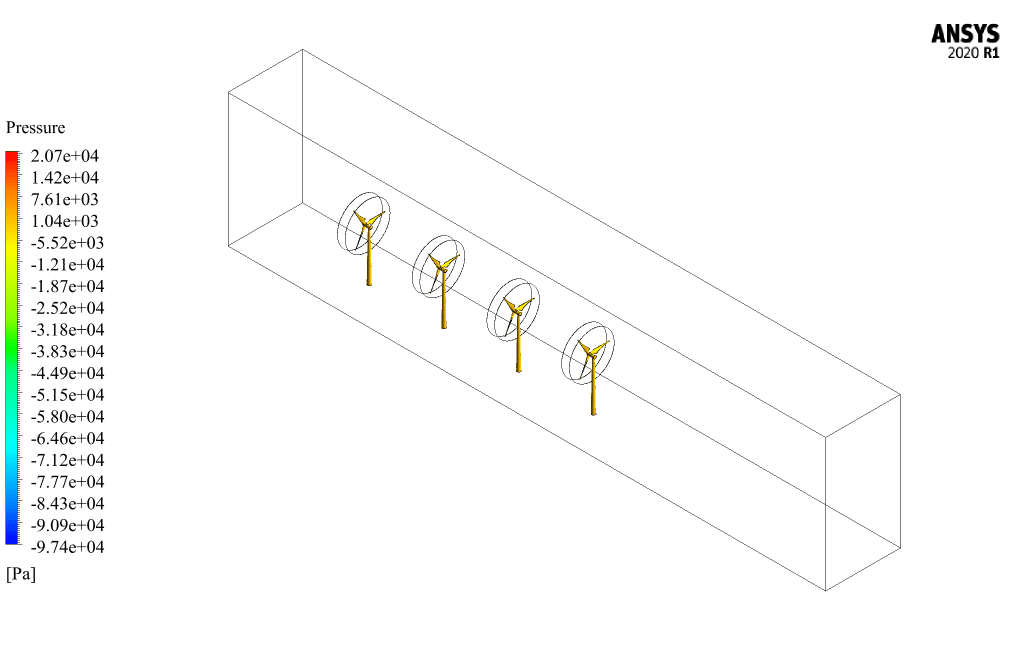
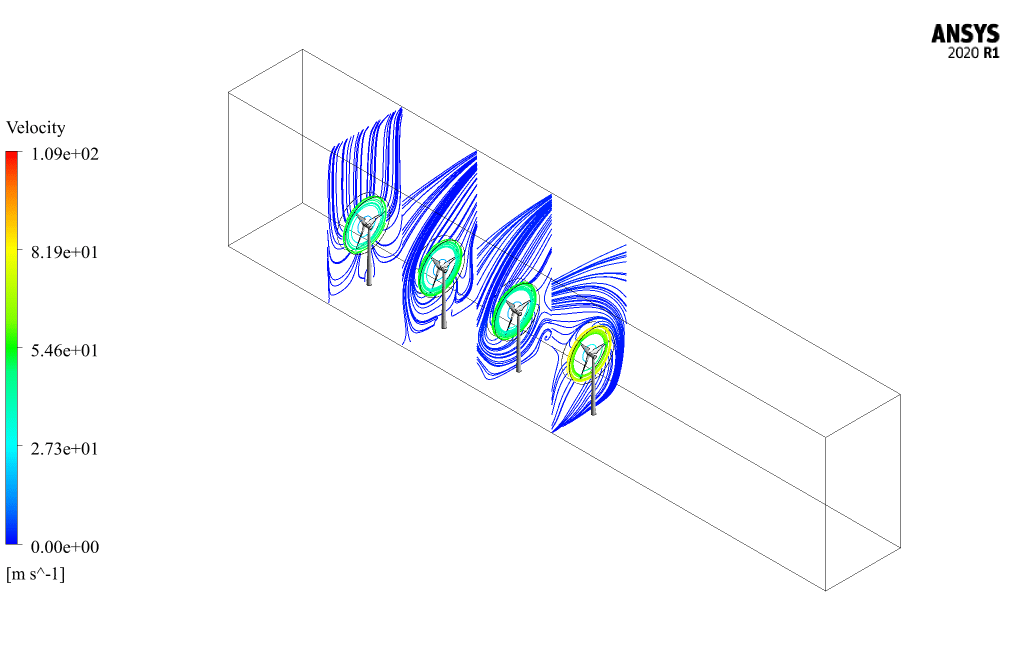
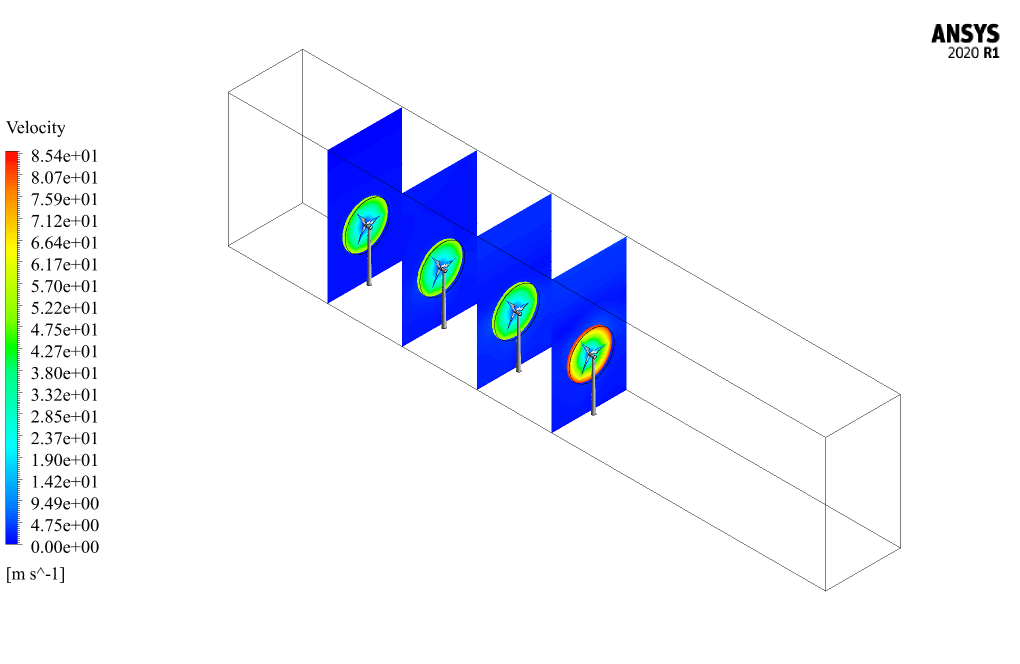
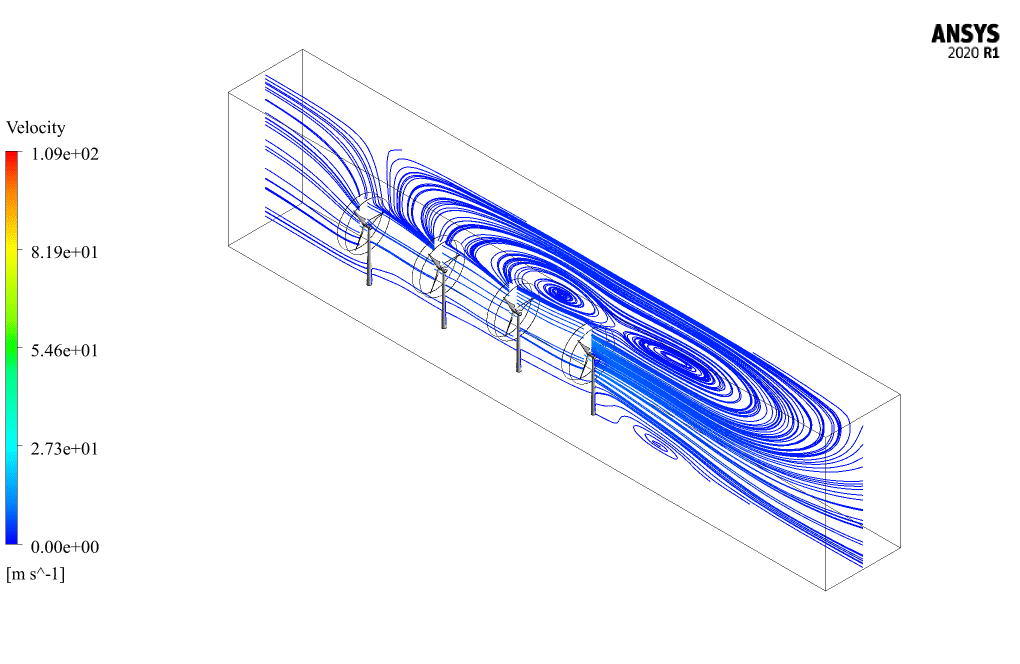
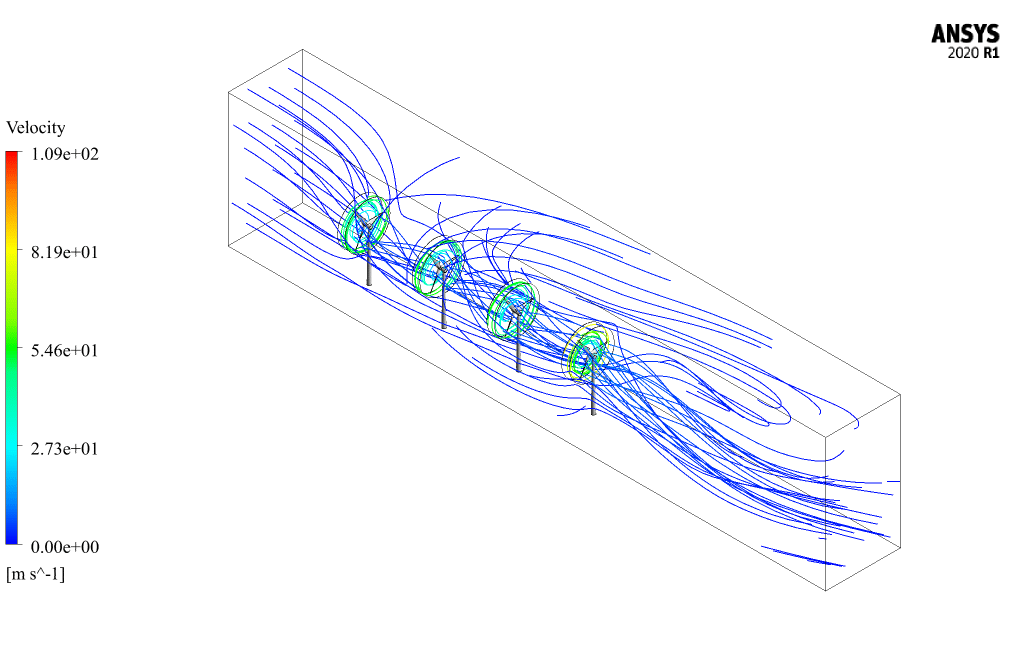
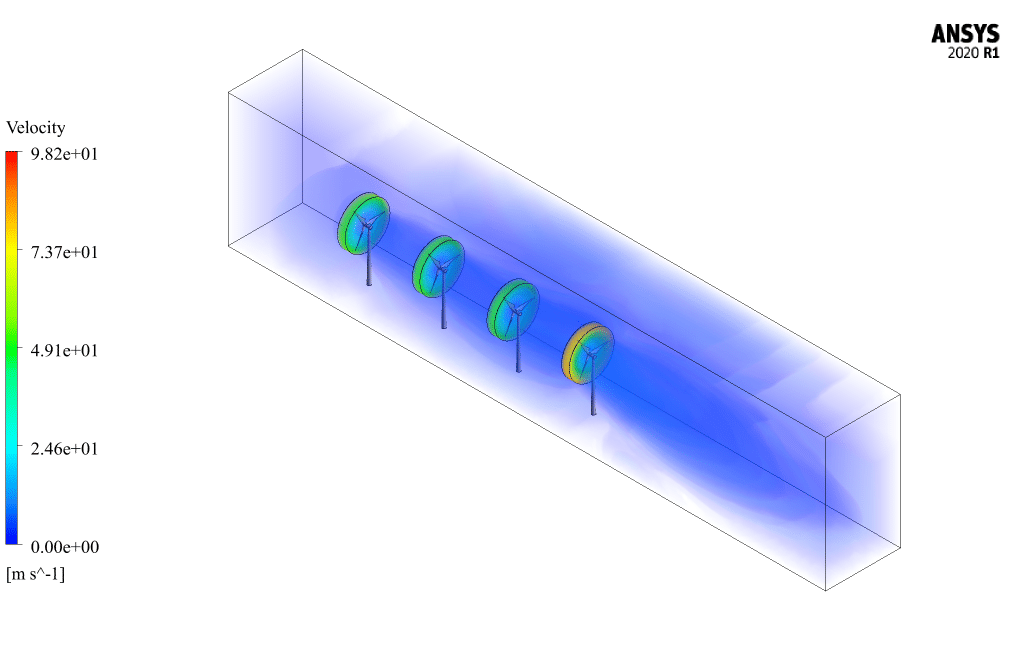

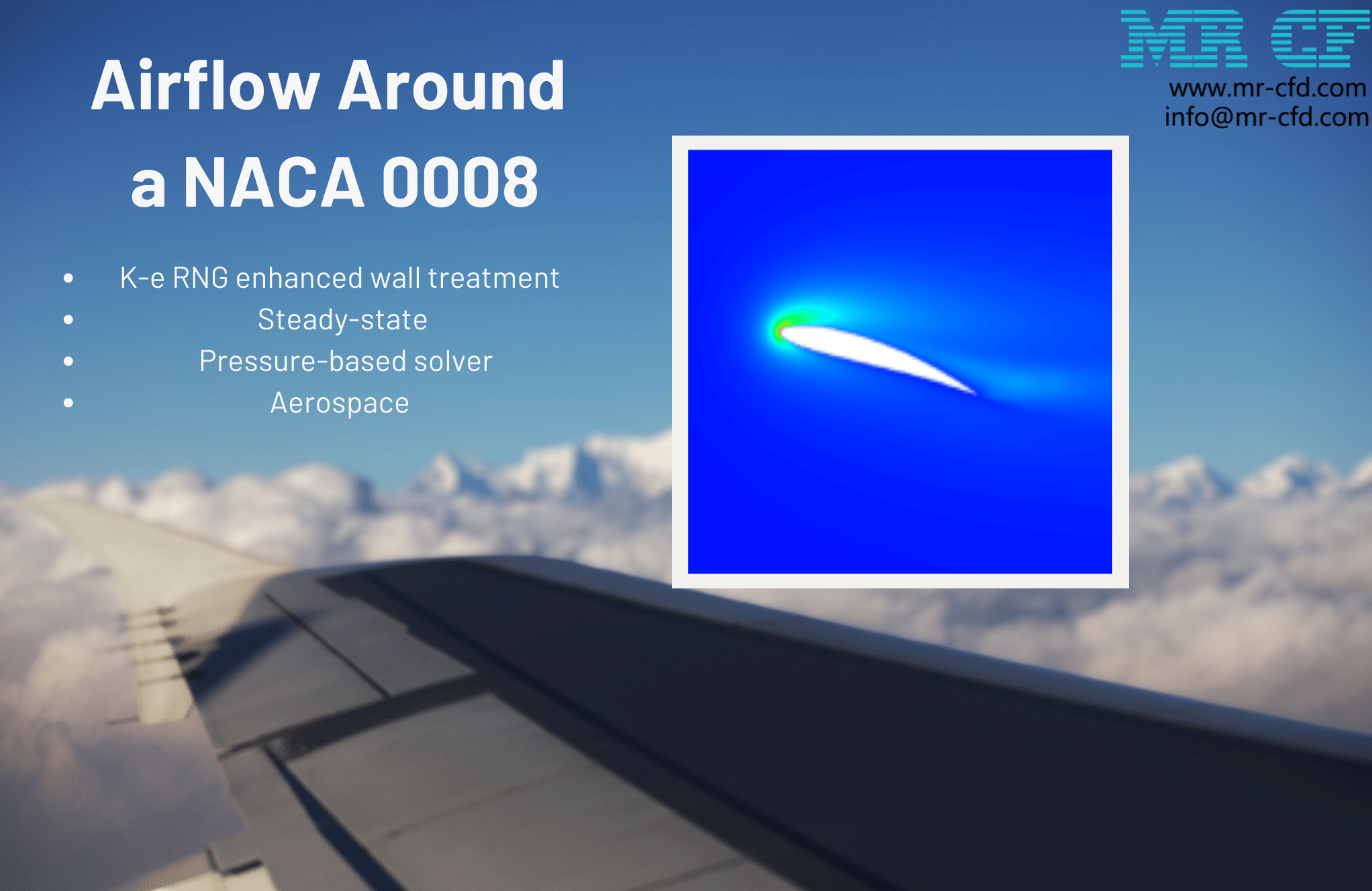


Wendy Orn –
The training materials seem comprehensive, so I was wondering if vortex generation and their interactions downwind of the turbines are addressed in the simulation?
MR CFD Support –
In the simulation the complex flow phenomena including the vortex generation behind the wind turbines as well as their interactions with turbines further downwind are captured. Utilizing the SST k-omega model allows this simulation approach to more accurately detail the flow separation, turbulent wakes, and the resulting vortex structures which are critical for understanding the aerodynamic performance of turbines in series.
Mrs. Estel Kunze –
This wind farm series arrangement simulation has opened my eyes to the interactions between turbines in an array. The visuals really helped me grasp the airflow dynamics. Fantastic learning experience!
MR CFD Support –
Thank you for your kind words! We’re delighted to hear that the simulation provided valuable insights and that the visual elements enhanced your understanding of the complex airflow dynamics among the turbines. Your feedback is much appreciated!
Verner Gislason I –
I was thoroughly impressed with the level of detail in the ‘Wind Farm with Series Arrangement’ CFD simulation training. It provided a comprehensive analysis that was crucial in helping me understand the interaction between turbines in a wind farm. The clear visualization of velocity and pressure gradients around the turbine blades enhanced my grasp of wind dynamics in such environments. Excellent resource!
MR CFD Support –
Thank you for your kind words! We’re delighted to hear that our ‘Wind Farm with Series Arrangement’ CFD simulation training was helpful and provided you with a clear understanding of the interactions in a wind farm environment. We strive to offer detailed and informative content to aid in learning and are glad that we met your expectations. Your feedback is greatly appreciated, and we look forward to providing you with more quality learning materials in the future!
Moriah Mann –
I was thoroughly impressed with the way the Wind Farm with Series Arrangement simulation captured the complexity of rotor interactions in the wind farm setting. The speed contours near the blade tips were particularly illuminating.
MR CFD Support –
Thank you so much for your appreciation of our Wind Farm with Series Arrangement simulation! We’re thrilled to hear that the details in the speed contours provided valuable insights. Your feedback inspires us to continue delivering high-quality CFD simulations. If you have any further questions or need assistance with future projects, please don’t hesitate to let us know.
Alexane Swift –
The methodology of the simulation seems comprehensive, but is there any data on the wake effect and how each turbine affects the downstream turbines’ performance?
MR CFD Support –
In this simulation, the effect of the turbine wake on downstream turbines has been studied by analyzing velocity and pressures contours. The data looks at how the rotational motion of one turbine affects the wind flow and subsequently influences the wind speed and pressure at the location of the next one. To know about the specific impacts on performance, such as power output efficiency of downstream turbines, it would typically require calculating the turbine’s performance using specific formulas based on the change in wind speed at the rotor disk and in the wake region.
Prof. Axel Rath I –
The CFD Training for Wind Farm with Series Arrangement was outstanding! It effectively combined theoretical concepts and practical application using ANSYS Fluent. The detailed approach helped me to understand the dynamics of wind farms better.
MR CFD Support –
Thank you for your positive feedback! We are thrilled that our training facilitated a deeper comprehension of wind farm dynamics and that you appreciated the blend of theory and practical ANSYS Fluent application. Your satisfaction is our top priority, and we look forward to providing you with more quality educational material.
Cassandre Kub –
The training course on Wind Farm CFD simulation is impressively structured. The explanation of the Frame Motion method for turbine rotation and the use of the SST k-omega model provide profound insights into the complexity of wind turbine interactions in a farm setup. The comprehensive data analysis and visualization techniques evident in the course further enhance my understanding of the flow dynamics involved.
MR CFD Support –
Thank you for your feedback! We’re thrilled to hear that our training course on Wind Farm CFD simulation has deepened your understanding of wind turbine interactions and flow dynamics. We strive to provide detailed and clear explanations to help learners like yourself gain a thorough comprehension of such complex systems. Your appreciation motivates us to continue creating high-quality content! If you have any further inquiries or need assistance with other CFD topics, please feel free to reach out.
Berenice Schneider Sr. –
I’m really impressed with the level of detail in the simulation of the wind farm and the use of the SST k-omega model. Understanding the interactions between the turbines is crucial for efficient wind farm design!
MR CFD Support –
Thank you for your kind words! We strive to provide detailed and accurate simulations to aid in optimizing designs such as wind farms. The SST k-omega model is indeed very effective in capturing the complex flow phenomena around the turbines. We’re glad you found the insights on turbine interactions informative!
Muhammad Schuppe –
From the review, it’s great to see that the project examines the interactions between turbines. Can you clarify if these interactions have any significant impact on overall efficiency in a wind farm with a series arrangement?
MR CFD Support –
In a wind farm with turbines arranged in series, the interactions between turbines can significantly impact overall efficiency. This is due to the wake effect, where upstream turbines can reduce the wind speed for those downstream, leading to lower power output from the latter. The CFD analysis in this project helps to visualize and quantify these interactions to optimize turbine placement and maximize overall efficiency of the wind farm.
Dr. Hank Rempel Sr. –
I’m really impressed by the attention to detail in defining the rotational motion of the wind turbines using the Frame Motion method. The distinction between the rotating airflow around the blades and the blades themselves is a fantastic approach to simulate the wind turbine operation!
MR CFD Support –
We’re thrilled to hear that you appreciate the methodology used in the Wind Farm CFD Simulation training. It’s our pleasure to provide detailed and accurate simulation practices that meet your expectations. If you have any further questions or require additional training materials, feel free to reach out. Thank you for your positive feedback!
Luna Hickle –
I’ve gone through the full training, and I must say I’m quite impressed with the level of details on simulating the wind farm using ANSYS Fluent.There’s a wealth of information presented in an accessible way, especially how the Frame Motion method is applied to replicate the turbines’ rotation. The explanation on blade rotation interactions within the series arrangement provided excellent insights into real-world turbine behaviors. Well done MR CFD Company on a comprehensive CFD training package!
MR CFD Support –
Thank you for your kind words! We are thrilled to hear that you found the Wind Farm with Series Arrangement, ANSYS Fluent CFD Simulation Training comprehensive and informative. We worked hard to ensure the material was both detailed and user-friendly, so it’s great to see it was appreciated. If other questions or interests arise, please don’t hesitate to contact us. We look forward to assisting you further in your CFD learning journey!
Arnulfo Hahn –
I’m incredibly impressed with the visualization of the interaction between the wind turbines! The detail in the pressure and velocity contours gave me a great understanding of the flow dynamics at play.
MR CFD Support –
Thank you for your positive feedback! We’re glad that our simulation provided valuable insight into the flow dynamics around the wind turbines. If you have any more questions or need further information, feel free to ask. We’re here to help!